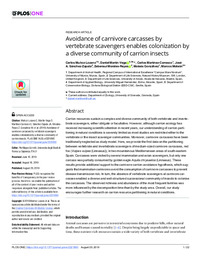Título :
Avoidance of carnivore carcasses by vertebrate scavengers enables colonization by a diverse community of carrion insects |
Autor :
Muñoz-Lozano, Carlos
Martín-Vega, Daniel
Martínez-Carrasco Pleite, Carlos 
Sánchez Zapata, José Antonio 
Morales-Reyes, Zebensui
Gonzálvez Juan, Moisés 
Moleón, Marcos |
Editor :
Public Library of Science |
Departamento:
Departamentos de la UMH::Biología Aplicada |
Fecha de publicación:
2019-08-29 |
URI :
https://hdl.handle.net/11000/33890 |
Resumen :
Carrion resources sustain a complex and diverse community of both vertebrate and invertebrate scavengers, either obligate or facultative. However, although carrion ecology has received increasing scientific attention in recent years, our understanding of carrion partitioning in natural conditions is severely limited as most studies are restricted either to the vertebrate or the insect scavenger communities. Moreover, carnivore carcasses have been traditionally neglected as study model. Here, we provide the first data on the partitioning between vertebrate and invertebrate scavengers of medium-sized carnivore carcasses, red fox (Vulpes vulpes (Linnaeus)), in two mountainous Mediterranean areas of south-eastern Spain. Carcasses were visited by several mammalian and avian scavengers, but only one carcass was partially consumed by golden eagle Aquila chrysaetos (Linnaeus). These results provide additional support to the carnivore carrion-avoidance hypothesis, which suggests that mammalian carnivores avoid the consumption of carnivore carcasses to prevent disease transmission risk. In turn, the absence of vertebrate scavengers at carnivore carcasses enabled a diverse and well-structured successional community of insects to colonise the carcasses. The observed richness and abundance of the most frequent families was more influenced by the decomposition time than by the study area. Overall, our study encourages further research on carrion resource partitioning in natural conditions.
|
Área de conocimiento :
CDU: Ciencias puras y naturales: Biología |
Tipo de documento :
info:eu-repo/semantics/article |
Derechos de acceso:
info:eu-repo/semantics/openAccess
Attribution-NonCommercial-NoDerivatives 4.0 Internacional |
DOI :
https://doi.org/10.1371/journal.pone.0221890 |
Publicado en:
Plos One, 2019 |
Aparece en las colecciones:
Artículos Biología Aplicada
|
 La licencia se describe como: Atribución-NonComercial-NoDerivada 4.0 Internacional.
La licencia se describe como: Atribución-NonComercial-NoDerivada 4.0 Internacional.
.png)
